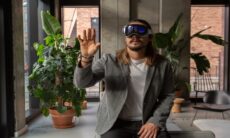An industrial technology service provider is helping the UK achieve its vision of more ventilators utilising the advancements provided by augmented reality (AR) technology.
PTC was included among the partners for the ‘VentilatorChallengeUK’ conference, under the leadership of Dick Elsy, the CEO of High Value Manufacturing Catapult, and as a host of the many prominent UK engineering companies, including GKN Aerospace, Airbus, Siemens UK, Meggitt, and Ford Motor Company. Work has been going in collaboration with current ventilator manufacturers Penlon and Smiths Group for documenting the critical assembly steps required to develop and construct the Rapidly Manufactured Ventilator Systems (RMVS).
The Hololens from Microsoft and the Vuforia Expert Capture AR technology from the PTC stable was utilised for the consortium. These were used for capturing the key steps for assembly and the processes needed for building Rapidly Manufactured Ventilator Systems (RMVS). The data and observations obtained through this process will be transferred and tweaked within the Vuforia Editor offered by PTC, which uses the Microsoft Azure platform to run. It generates a virtual assembly guide, which is delivered through the AR equipment or on devices such as tablets and smartphones. The information can then be received and utilised by consortium partner factors that usually do not manufacture ventilators.
The safety of the workers putting in their efforts for the project is being prioritised by the group and the reason why AR technology is being considered as the suitable choice for taking away the threats they might potentially be exposed to. Augmented reality enables assigning a virtual ventilator expert within the partner factory, thereby reducing the virus spread risks.
Paul Haimes, the Vice President of Field Engineering, PTC, described the response from the nation’s manufacturing sectors for the sudden cross as being unprecedented. He expressed enthusiasm about being able to extend support for the ‘VentilatorChallengeUK’ group for developing two new production lines for ventilators within a period of few weeks, stressing that such an achievement could only be possible within a six month period.
Haimes elaborated further, saying that the core of the augmented reality project needed the transmission of skills, expertise and intellectual property from the Penlon and Smiths production lines to newer facilities. He emphasised that the transfers of required materials were achieved using augmented reality technology. According to Haimes, the building phase requires more than 24 hours. He also stated that the entirety of all the stages was captured through the Vuforia Expert Capture (VEC) application with the help of an individual wearing a pair of HoloLens glasses.
Haimes continued his explanation of the process, saying that the information and specifics captured were then uploaded to the Azure Cloud platform and edited. Edits helped untrained and inexperienced manufacturers gain comprehensive insights into the different steps of ventilator production. They are required to put on HoloLens glasses or observe the instructions on smartphones or tablets. Haimes also revealed that the footage is equipped with annotations to help users combat any issues that crop up.










